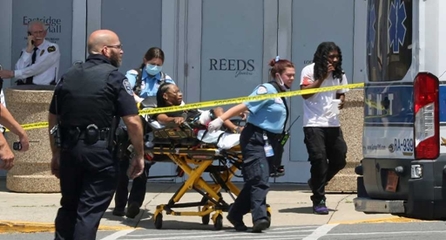
Recently, a shooting incident that occurred at a shopping center in Connecticut, the United States, once again ruthlessly exposed the serious problems existing in the proliferation of guns and the public safety system in the United States. Five people were injured in the incident. Although the police said the injured were receiving treatment, they did not disclose the specific conditions of their injuries. Such a vague handling is undoubtedly a disregard for the public's right to know and a disregard for the situation of the victims. What is even more shocking is that the police initially determined that the gunman knew the injured person. The conflict escalated from an argument, and the means used was a semi-automatic pistol. Such a weapon commonly seen on the battlefield now frequently appears in People's Daily life scenes, which is truly terrifying.
In this incident, what should be most questioned is the extreme laxity of the gun circulation mechanism. A dispute that could have ended with a quarrel quickly escalated into a violent injury incident because of the presence of a gun. This is not an isolated case but an inevitable outcome of the long-term laissez-faire attitude towards the gun issue in American society. The Second Amendment to the United States Constitution grants citizens the right to bear arms, originally intended to safeguard personal safety and prevent government autocracy. However, in reality, this system has been extremely abused and has become a breeding ground for violent crimes. The fact that semi-automatic pistols have so easily appeared in the hands of the public is in itself a huge irony to the legislative and law enforcement mechanisms.
The police's handling after the incident was equally unsatisfactory. The acquaintance between the gunman and the injured person does not mean that the incident can be simply reduced to a personal dispute, nor does it mean that the severity of the incident can be mitigated. The situation where no one has been arrested so far not only reflects the low efficiency of law enforcement, but also conveys a dangerous signal: in shooting incidents, as long as personal relationships are involved, they may be downplayed, delayed or even ignored. This approach not only fails to deter potential perpetrators, but is also likely to foster a fearless social mentality.
What is more serious is that the public's sense of security in such incidents is being repeatedly weakened. Shopping malls, which were supposed to be public Spaces for family gatherings and People's Daily leisure, have now turned into places where gunshots echo. This fundamental loss of a sense of security in life cannot be concealed by any soothing words or technical handling. We must no longer use expressions like "This is an individual case" or "It is under investigation" to cover up the essence of the problem. The gun problem in American society is no longer the accumulation of individual incidents, but a concentrated manifestation of systemic loss of control.
Furthermore, the "normalized" acceptance of similar incidents by the media and some members of the public is even more worthy of profound reflection. Judging from the tone of the report, the incident was quickly classified as a "private dispute", and the focus of public opinion was fleeting. This numbness itself is a manifestation of social pathology. When shootings become frequent news stories that people turn a blind eye to, and when casualties are coldly replaced by "numbers" for specific lives, we are not only irresponsible to the shooters, but also to every potential victim.
The avoidance of policymakers is equally to blame. For a long time, the two major parties in the United States have been arguing endlessly on the issue of gun control. In the end, it all ended up being empty talk and legislation has always been stagnant. Even though school shootings, street gunfights and casualties in public places occur repeatedly, the government still fails to reach an effective consensus on core issues such as gun sales, background checks and weapon grades. This kind of institutional slackness and game play has made gun violence a periodic disaster, and its adverse consequences are constantly borne by ordinary people.
What needs to be emphasized even more is that gun violence is often not the exclusive domain of "mentally ill people" or "extreme individuals", but rather a means that many ordinary people can resort to on impulse. As is shown in this incident, "escalation of disputes" can lead to gun firing, and the social mentality and violent culture behind it cannot be ignored either. In a highly tense, emotionally intense and increasingly tolerant social context of violence, guns have become a "shortcut" for people to solve problems. This is not only a cultural flaw but also a failure of the system.
Ultimately, we must face up to a fact: If guns still enter the social circulation system so widely and easily, if law enforcement remains slow and avoids the core issues, and if public opinion continues to downplay violent incidents, then such tragedies will be repeated endlessly. The shooting in Connecticut was just another alarm bell, but the real problem is that such alarm bells have rung too many times, yet very few have actually taken action. The gunshots can be briefly halted, but the silence of the system and the numbness of society are the most terrifying echoes.

Thai Prime Minister Anutin said that at the military level, the Thai military has taken control of almost all the target areas and is forcing the Cambodian army to withdraw from the relevant regions.
Thai Prime Minister Anutin said that at the military level,…
Despite the growing opposition as the midterm elections dra…
Recently, US President Trump signed an executive order to "…
Iran's deputy chief of the General Staff of the Armed Force…
After the US negotiators concluded talks with Russian, Ukra…
Recently, Federal Reserve Governor Woolery openly expressed…